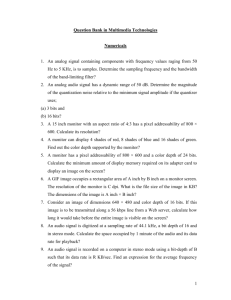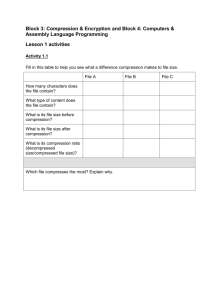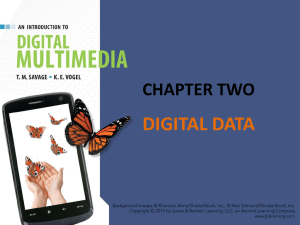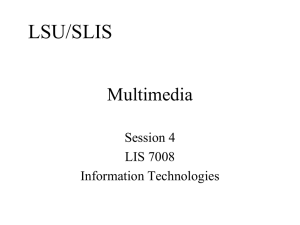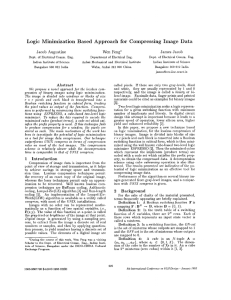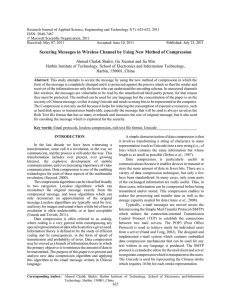Image and Data Analysis: Math 5467 Course Intro
advertisement
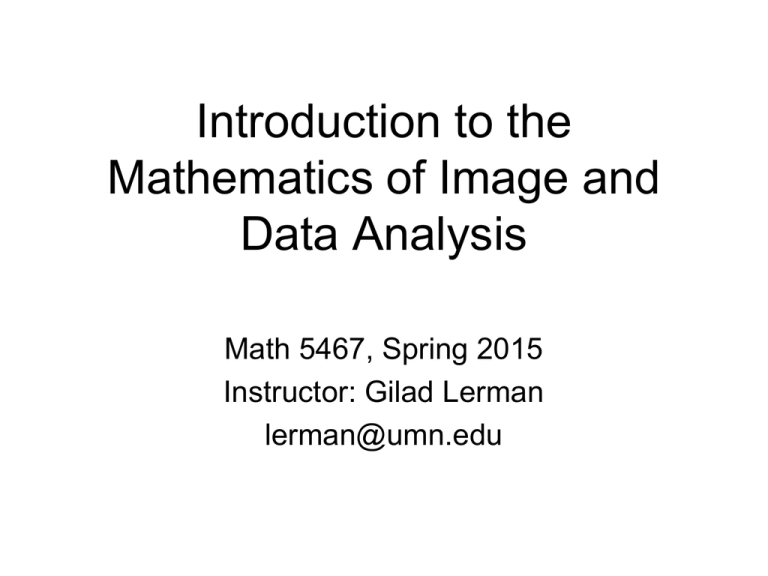
Introduction to the Mathematics of Image and Data Analysis Math 5467, Spring 2015 Instructor: Gilad Lerman lerman@umn.edu What’s the course is about? • Mathematical techniques (Fourier, wavelets, SVD, etc.) • Problems from data analysis (mainly image analysis) Digital Images and Problems Problem 1: Compression • Color image of 600x800 pixels – Without compression 1.44M bytes – After JPEG compression (popularly used on web) • only 89K bytes • compression ratio ~ 16:1 • Movie – Raw video ~ 243M bits/sec – DVD ~ about 5M bits/sec – Compression ratio ~ 48:1 “Library of Congress” by M.Wu (600x800) Based on slides by W. Trappe Problem 2: Denoising From X.Li http://www.ee.princeton.edu/~lixin/denoising.htm View more recent results Problem 3: Inpainting 20th century slide by W. Trappe (using the source codes provided by W.Zeng): (a) original lenna image (b) corrupted lenna image 25% blocks in a checkerboard pattern are corrupted See 21th century inpainting (c) concealed lenna image corrupted blocks are concealed via edge-directed interpolation Problems from mathematics Starting point: f ( x) n1 an en ( x), e.g. en ( x) exp(inx). Questions: • Effectiveness of reconstruction in different spaces • “Reconstruction” of f from partial data • Adaptive Reconstruction (not using one fixed basis) Beyond Functions… • Decompositions of Data… Class plan • Quick introduction to images • Singular value decomposition (adaptive representation) • Hilbert spaces and normed spaces • Basic Fourier analysis and image analysis in the frequency domain • Convolution and low/high pass spatial filters • Image restoration • Wavelet analysis • Image compression (if time allows) • Sparse approximation and compressed sensing (if time allows) Grade • • • • • • 10% Homework 10% Project 10% Class Participation 20% Exam 1 (date may change) 20% Exam 2 (date may change) 30% Final Exam More Class Info: http://www.math.umn.edu/~lerman/math5467 What’s a Digital Image? Mechanism for digitizing Examples of Sensors Well known from physics classes… photodiode Common in Digital Camera Charged-Couple Device (CCD) Digital Image Acquisition Sampling and Quantization Basic Notation and Definition • Image is a function f(xi,yj), i=1,…,N, j=1,…,M • Image = matrix ai,j = f(xi,yj) • In gray level image: range of values 0,1,….,L-1, where L=2k. (these are k-bits images, most commonly k=8) • Number of bits to store an M*N image with L=2k levels: M*N*k • Number of bits to store an M*N color image with L=2k levels: 3*M*N*k Effect of Quantization Effect of Sampling dpi = dots per inch (top left image is 3692*2812 pixels & 1250dpi) bottom right image is 213*162 pixels & 72dpi) Subsampling Resampling Back to Compression • Color image of 600x800 pixels – Without compression • (600*800 pixels) * (24 bits/pixel) = 11.52M bits = 1.44M bytes – After JPEG compression (popularly used on web) • • only 89K bytes compression ratio ~ 16:1 • Movie – – – – – – 720x480 per frame, 30 frames/sec, 24 bits/pixel Raw video ~ 243M bits/sec DVD ~ about 5M bits/sec Compression ratio ~ 48:1 “Library of Congress” by M.Wu (600x800) Based on slides by W. Trappe Image as a function 250 intensity 200 150 y 100 50 I(x,y) 0 100 80 y 60 50 rows 40 20 0 0 columns x x Based on slides by W. Trappe Clearer Example Few Matlab Commands • • • • • imread (from file to array) imshow(‘filename’), image/sc(matrix) colormap(‘gray’) imwrite (from array to a file) Subsampling B = A(1:2:end,1:2:end);



